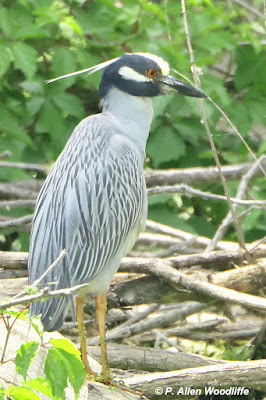An adult Yellow-crowned Night-Heron was the star of local birding in the last couple of days.
It was seen at the Keith McLean Conservation Lands, at the pond closest to the house. It was quite tolerant of the dozens of birders who came and went over several hours, giving extremely good views. The parking lot to the property got filled up quickly, and undoubtedly will continue to do so as the weekend has arrived.
There have been a few records for the Rondeau area in the past, but none since 1999, although with the extensive habitat present in the Rondeau vicinity, it is entirely possible that more have come and gone without being recognized. I have seen two, both an adult at a slough along Harrison Trail, and a sub-adult in a slough at the west end of Gardiner Ave, and managed to get photos of both.
While birding, at least related to migration, has slowed down somewhat, there has been a continuing trickle of migrants. Shorebirds in particular have been around where there is suitable habitat. A few days ago, the Erieau Rail Trail was good to see shorebirds. Black-bellied Plovers are always a highlight to see. There were at least 40 present while I was there, and showed various stages of plumage as the following two photos illustrate.
Dunlin are pretty regular....and were photographed along the beach/lake in the townsite of Erieau...
....as are Sanderling........and Semiplamated Sandpipers. I saw them also along the Rail Trail, but were too far away to get photos like these. Clearly the sandy/gravel beach was not on the mudflat!
Still along the Rail Trail were other birds on the shore, but not 'shorebirds' per se. Three or four Canvasback have been seen regularly. It is hard to know why they are still present, as they should be farther west and busily nesting.
This Mute Swan family also fell into that same 'shorebird' category.
The family of Great Horned Owls continue to be seen, at least from a distance. There are two owlets here, although the one at the lower right of the photo only shows a partial pic.
Other wildlife show up from time to time, including this family of Groundhog while I was photographing the plovers. There were actually two youngsters but the other one had already skedaddled out of the camera frame as this one was in the process of doing.....
...leaving momma to go back and keep an eye on them.
A visit to the Mitchell's Bay area turned up a few things. Black-bellied Plovers again, this time with some out in a field along the North Shore Trail, and a few more on the mudflats between the trail and the lake.
This one-legged Dunlin was able to hop around fairly easily, but I am unsure as to whether it could get enough to feed on to attain the energy required to get it to its northern breeding territory.
A single Ruddy Turnstone in fairly full breeding plumage was there....
...as were three Semipalmated Plovers.
Great Egrets are, of course, quite regular since there is a breeding colony a couple of kilometres away. When they are at the edge of a pond feeding, I find them quite wary and quick to depart.
If I come across one in a tree, they seem to feel much safer looking down on me and allow a closer approach without showing much concern.
A pair of Sandhill Cranes flew by. There is often a pair in the area.
And Mute Swans....what can I say. There are usually several dozen within view, although since this one, I thought, was photogenic so I obliged.
An Eastern Kingbird paused briefly for a photo shoot.
On an outing to Rondeau a few days ago, I was concentrating mainly on forest photography. The smoky skies allowed for an evenness in the light, reducing the contrast one will typically encounter on a bright sunny day. More on that in a future post. But I kept an eye and ear open for birds, and came across these along Tuliptree Trail. Most were in the lower canopy, giving some challenging light conditions to work with.
There were at least a dozen Cedar Waxwings....
...and the local, resident Acadian Flycatcher cooperated better than usual.
Hunkered down into some regenerating Green Ash was this Yellow-bellied Flycatcher.
Continuing with a flycatcher theme, in a more open spot with a blue sky, was this Eastern Wood-Pewee.
If you would like to subscribe, or unsubscribe, to Nature Nuggets, contact me at: prairietramper@gmail.com






























The highlights for me were:- Ruddy Turnstone in it's beautiful breeding plumage is rather special, the Yellow-crowned Night-Heron - great news that it appears to be in residence again, and the Semipalmated Plover's dark back and necklace struck me too. Thanks for the introduction to these special birds.
ReplyDeleteThanks, Paula. Birds in their breeding plumage are certainly a highlight at this time of year!
DeleteHaven’t seen a bobolink for years. Used to see them regularly in the pasture at the farm. Nice collection of pictures.
ReplyDeleteThanks Susan. The decline in Bobolinks has been directly related to the decline in prairie and pasture, unfortunately making them an officially 'At Risk' species.
Delete